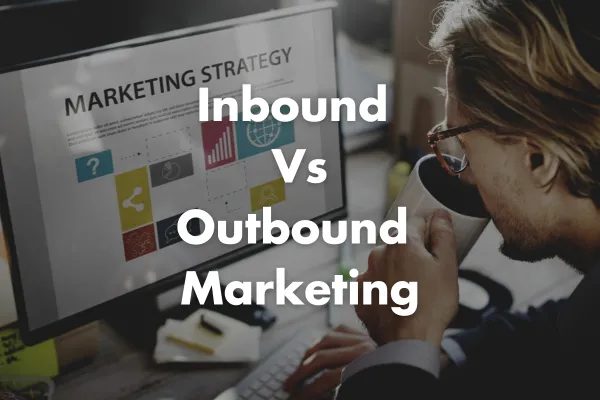
What's the Difference Between Inbound and Outbound Marketing?
Inbound and outbound marketing are two distinct approaches to reaching and engaging customers, each with its unique strategies and methodologies:
Inbound Marketing
Attracts Customers: Inbound marketing focuses on creating content or experiences tailored to the interests and needs of potential customers, attracting them towards the company or product.
Permission-Based: This approach often relies on gaining permission from the audience to send them information, such as through email subscriptions or following on social media.
Content-Driven: Inbound marketing is heavily reliant on content creation – blogs, videos, podcasts, social media posts, etc. – which is designed to be valuable and engaging to the target audience.
Interactive and Educational: It tends to be more interactive, often involving educational materials, webinars, or helpful tools that engage the audience and solve their problems.
Digital Focus: Inbound strategies are primarily executed online, utilizing SEO, social media, and content marketing to draw in digital audiences.
Customer-Centric: It is customer-focused, aiming to meet users at various stages of their buying journey with relevant and helpful information.
Builds Relationships: Inbound marketing aims to build a relationship with the audience over time, creating trust and brand loyalty.
Cost-Effective in Long Term: While it can take time to see results, inbound marketing is often more cost-effective in the long run, as it focuses on creating lasting relationships with customers.
Outbound Marketing
Pushes Products/Services: Outbound marketing involves pushing a message out to a large audience, often regardless of whether the audience has shown interest in the product or service.
Interruption-Based: This method can be seen as interruptive, as it involves reaching out to potential customers without their prior consent or interest.
Media and Advertising Driven: It heavily relies on traditional media such as TV ads, print ads, radio, direct mail, telemarketing, etc.
Broad Targeting: Outbound marketing often targets a broad audience, aiming to reach as many people as possible, in contrast to the targeted approach of inbound marketing.
Less Interaction: There's usually less direct interaction between the company and the consumer in outbound marketing, focusing more on one-way communication.
Product-Centric: It is often more product-centric, focusing on the features and benefits of the product or service being sold.
Quick Results: Outbound strategies can yield quicker results in terms of visibility and reach, but may not always result in immediate sales.
Higher Initial Costs: These campaigns can be expensive, requiring significant investment in media and advertising channels.
Inbound Marketing Strategies:
Content Marketing: Creating and distributing valuable, relevant, and consistent content to attract and engage a clearly defined audience, with the objective of driving profitable customer action.
SEO (Search Engine Optimization): Optimizing your website and content with relevant keywords to rank higher in search engine results pages (SERPs), making it easier for potential customers to find you.
Social Media Marketing: Using platforms like Facebook, Twitter, LinkedIn, and Instagram to create engagement, build community, and share valuable content to attract followers and convert them into customers.
Email Marketing: Sending targeted, personalized emails to a segmented list of subscribers to educate, inform, or offer solutions to their problems, thus nurturing leads into customers.
Blogging: Regularly publishing blog posts that provide valuable information or insights relevant to your target audience, establishing your brand as a thought leader in your industry.
Influencer Collaborations: Partnering with influencers or thought leaders in your industry to reach a broader audience and gain credibility through association.
Webinars and Online Workshops: Hosting online events to educate your audience about your industry or products, providing value and building relationships.
User-Generated Content: Encouraging customers to create content related to your brand, which can be shared on your platforms, creating authenticity and trust.
Referral Programs: Creating programs that incentivize current customers to refer new customers, leveraging word-of-mouth marketing.
Interactive Tools and Calculators: Developing online tools or calculators that provide value to your potential customers, encouraging engagement with your brand.
Outbound Marketing Strategies:
Cold Calling: Making unsolicited calls to potential customers to pitch your products or services.
Direct Mail: Sending physical mail, like postcards, brochures, or catalogs, directly to potential customers.
Traditional Advertising: Using traditional media like TV, radio, newspapers, and magazines to reach a broad audience with your marketing message.
Trade Shows and Conferences: Participating in industry events to showcase your products or services, network with potential clients, and build brand awareness.
Email Blasts: Sending a single email message to a large group of people, often a non-segmented audience, to promote a product, service, or event.
Print Advertising: Placing ads in newspapers, magazines, brochures, or other printed materials for distribution.
Telemarketing: Using telephone calls to directly market your products or services to potential customers.
Out-of-Home Advertising: Utilizing billboards, transit ads, and other outdoor media to reach consumers while they are outside their homes.
Paid Online Advertising: Using platforms like Google Ads or social media paid advertising to reach a targeted audience.
Door-to-Door Sales: Visiting potential customers at their homes or businesses to present and sell your products or services directly.
Conclusion
The key difference lies in their approach: inbound marketing pulls interested customers in, while outbound marketing pushes messages out to a broader audience. Inbound is more about building relationships and providing value, making it a more subtle and customer-centric approach, whereas outbound is more direct and product-focused, aiming for immediate visibility and reach.
Each of these strategies has its strengths and can be effective in different scenarios depending on your target audience and marketing objectives.
